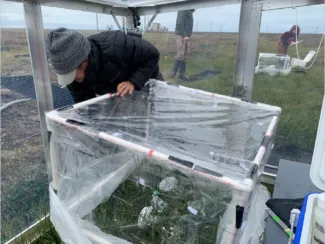Isotopic labels elucidate the impact of a single warm growing season on belowground interactions among plants, soils, and microbes.
Warming summer temperatures have been linked to increased greenness and shifts in plant community composition in nutrient-limited Arctic ecosystems. Therefore, a study was conducted to determine whether elevated temperatures would affect belowground carbon and nitrogen dynamics in the tundra. Two field campaigns were conducted in Utqiaġvik, Alaska, where zero-power warming chambers were sampled. These chambers were placed over a plant community for a single growing season with elevated air and soil temperatures by up to 4°C and 1°C, respectively. To understand the impact of warming on both carbon and nitrogen cycling, in 2018, uptake of 15N-NH4 from the soil by the arctic grass Arctagrostis latifolia was quantified. In 2021, the aboveground uptake of 13C-CO2 by the sedge Carex aquatilis was examined. Together, these experiments allowed for tracing the path of nitrogen up from the soils through plant tissues, as well the path of carbon downward from plant leaves, through roots, and into the rhizosphere. In 2018, the team found that soil nitrogen and phosphorus availability increased significantly with one season of warming, but biomass nitrogen and phosphorus pools of A. latifolia did not. Nitrogen uptake was not impacted by warming, but there was a strong relationship between soil NH4 availability and uptake, provided these variables were expressed in spatially explicit units (NH4 per cubic centimeters of soil and uptake per meter of fine root). In 2021, the team collected daily leaf and pore water samples and measured pools of soil, plants, and microbes 1 week after the application of 13C-CO2. Preliminary observations showed the formation of Fe oxide plaques on root surfaces, indicating that oxygen is flowing from the plant roots to the rhizosphere. Future analyses will quantify allocation of recent photosynthate within plant tissues, as well as the transfer of carbon from C. aquatilis to soil pore water and microbes.


